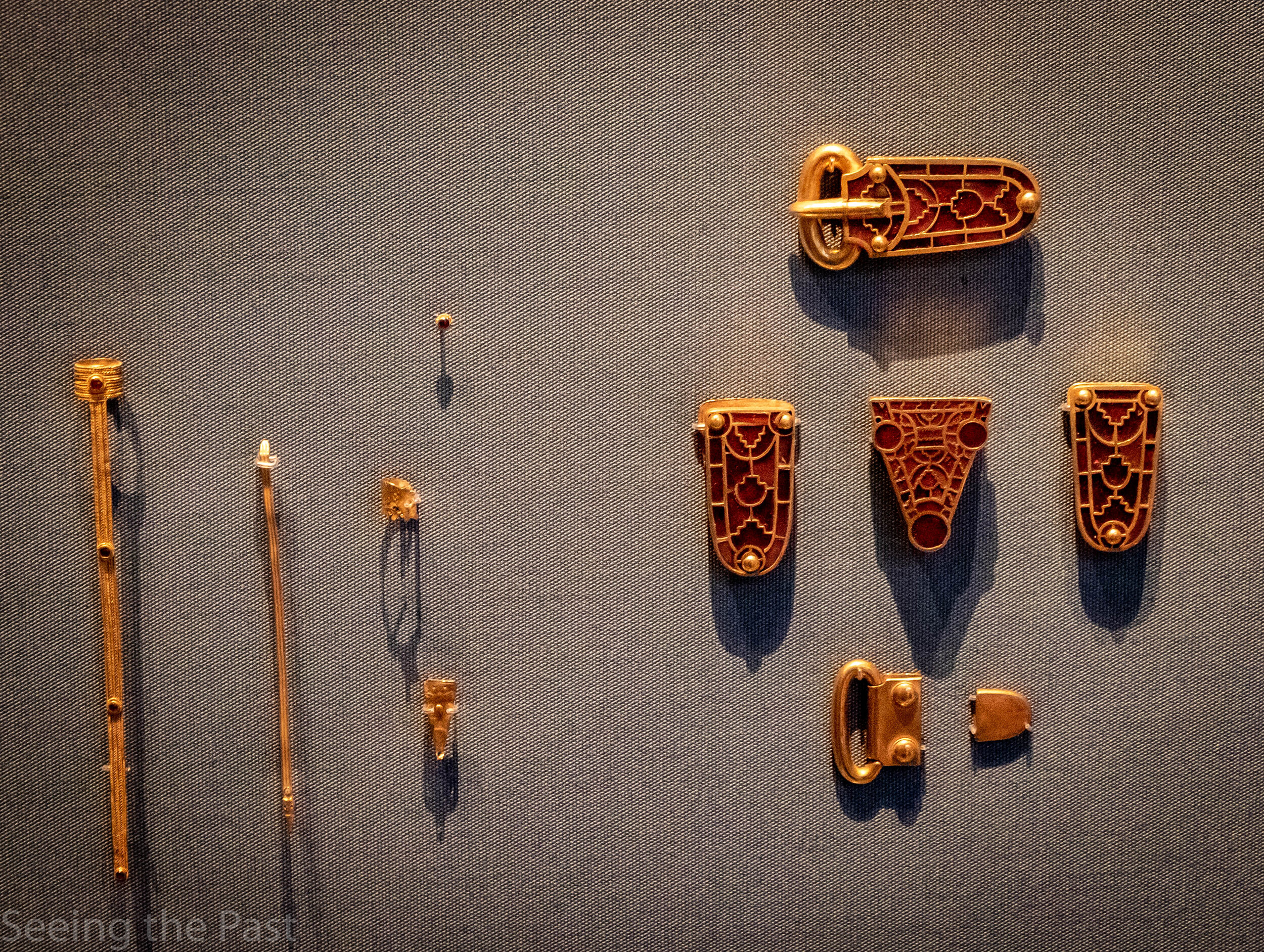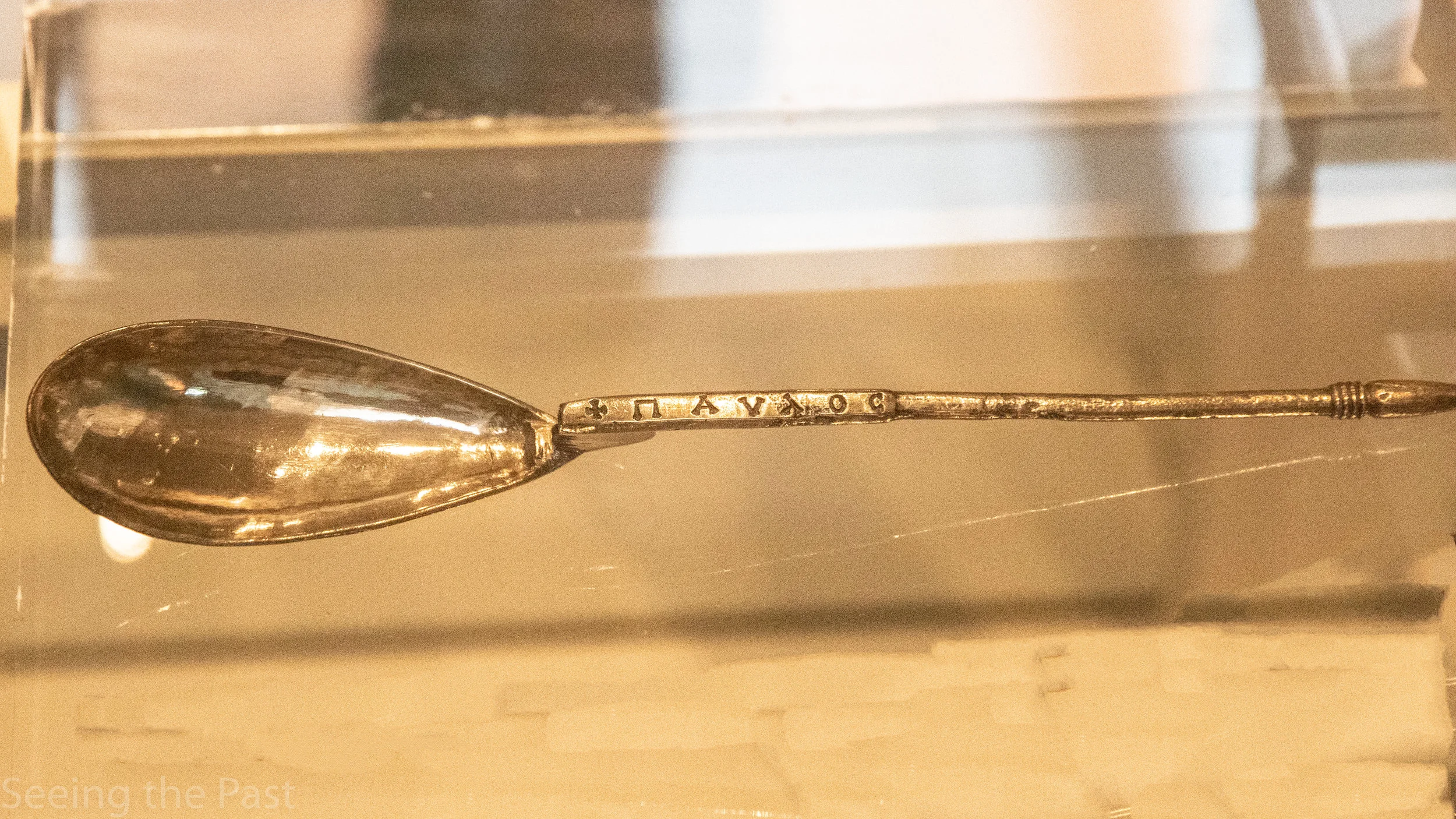Sutton Hoo, “One of the most spectacular and important discoveries of British archaeology”', according to the British museum.
/What was discovered at Sutton Hoo in Suffolk? Why has it been described as spectacular? Who owned the treasure and what do we know about him? All will be revealed in this blog.
Unfortunately the body of the shield had disappeared but the shield decorations survived
Gold and garnet, pins and “bling”.
Treasure hoard discovered in a ship burial in the 1930s
Until 1939, what looked like an innocuous small hill with several mounds overlooking the River Deben had not yielded any of its precious secrets. However, after excavating 3 of them without any luck, Basil Brown literally struck gold In what was called mound 1. He discovered the ghostly outline of a 27 metre packed with treasure. The surrounding soil was acidic and so all the wood had disappeared but it did leave the outline in the sand of where the planks forming the hull once existed.
Who was buried in the Sutton Hoo ship burial?
We do not know for certain because a body was never found. Inside the ship experts could see a body-shaped void with spectacular grave goods appropriately placed around it. A lot of effort was made to create such a monument and therefore it must be to commemorate someone of outstanding importance from the local kingdom of the East Angles, made up of the counties of Norfolk and Suffolk. To begin with, a ship had to be dragged from the River Deben which would have taken an enormous amount of effort from a sizeable number of men and then several tons of soil heaped over it. Created in the early 600s AD, it is believed to be for King Raedwald although some experts believe it is that of Raedwald’s son, Eorpwald who succeeded his father in 624 AD.
So, who was King Raedwald?
Raedwald who reigned from 599-624 AD, had a great family name, “Wuffingas” named after his grandfather “Wuffa”! By 616 AD, Raedwald had risen in power and status to be the most powerful king south of Northumbria and in the key record of the period, “The Anglo-Saxon Chronicle”, he was referred to as the “Bretwalda” which meant “Britain-ruler” or “wide ruler”. That is to say he was a highly important man in Britain and as such warranted a ship burial with precious grave goods.
East Anglian kings traced their family line back to Roman caesers to increase their status. Of course this was all make believe but no one would challenge their claims. The design of the helmet was based on the Roman parade helmet and they adopted Christianity, the religion that came to England from Rome.
Anglo-Saxon coins.
Who were the Anglo-Saxons?
The Roman control of Britain came to an end in about 410AD. Not all Romans left and many Britons adopted Roman lifestyles abeing sometimes called, the Romano-British. Before the Roman withdrawal, their empire was being attacked from various Europeans, labelled “Barbarians” by the Romans and Romano Britain had its fair share of raids. Germanic tribes , Angles, Saxons and Jutes, raided the British coast and eventually began to settle. During the 5th and 6th centuries, seven kingdoms began to evolve; Northumbria, Mercia, Essex, Kent, Sussex, Wessex and East Anglia. These eventually were united and the kingdom of the England, under Aethelstan (894-939), the grandson of King Alfred the Great (847 - 899) came into being.
What treasure was found at Sutton Hoo?
Among the items found was a spectacular helmet, shoulder clasps, a gold belt buckle, a purse lid, many coins, a sword and silver bowls. These show that the Anglo-Saxons were skilled metal workers who were able to create intricate designs with a high quality of workmanship. The original helmet and the replica illustrate the artistry of these craftsmen.
Here the dragon has been highlighted
Look closely at the helmet and you can see that it has painstakingly been put together from hundreds of metal fragments. Unfortunately, it was probably shattered when the roof of the burial chamber collapsed and so is not complete. There are only four recognisable Anglo-Saxon helmets in existence of which this is one. It is made of iron but covered with copper alloy designs showing warriors in horned headgear dancing with swords and spears and mounted warriors trampling a fallen enemy who is fighting back by stabbing the horse. On the face mask you can see a huge flying creature with the eyebrows forming its wings and the moustache forming its tail. This creature is believed to be a dragon that gives the wearer greater confidence and power but will add to the terror of the opponent. To continue the design, the creature’s head meets the head of a serpent and this then goes over the top of the rest of the helmet. Parts of the eyebrows are made out of garnets that experts believe came from as far away as India or Sri Lanka.
A full size replica of the helmet
The shoulder clasps held together two pieces of leather or fabric and are made of gold and red gemstones called garnet. For people considered to be “barbarians” these clasps show an extraordinary level of craftsmanship. Behind the thin pieces of garnet is gold foil and this enables the gems to sparkle when the wearer moves. If you look carefully, you may be able to see some interlocking wild boar with tusks and eyes made out out minute pieces of blue glass.
The bottom photo shows a belt buckle made of gold with an intricate design and shows just how important the owner must have been. Ordinary people would could only dream of owning such items.
The British Museum have created this diagram to help you interpret the images on the belt buckle.
The king’s highly decorated purse lid.
Above you can see a highly decorated purse lid made of gold, garnet and a sheet of horn. Unfortunately the leather purse disappeared hundreds of years ago but the lid shows amazing craftsmanship depicting birds and 4 wolves devouring humans! Seventy - seven gold shillings made up the original contents of the purse, no doubt to be used in the afterworld or as some people have suggested, to pay the ghostly oarsmen to get him there. .
Silver bowl from the Byzantine empire
Treasure came from many places. Here is a baptismal spoon from the Byzantine empire with the greek inscription, “Paulos” on the handle.
Why are there christian goods in a pagan ship burial?
It is believed that King Raedwald visited Kent and became a christian. On returning to East Anglia he reconverted to paganism or possibly tried to be both a pagan and a christian. Evidence for this is that he had 2 alters created, one christian and the other pagan according to the a great source of information on this period, Bede. His pagan burial, in a ship with grave goods suggests he was seen as a pagan but the spoon above is seen as a baptismal spoon given to people when they convert to christianity and became baptised. The bowls with crosses on them suggest christianity but some have suggested the flower at the centre of the bowl is pagan!
Believe it or not, this beautiful collection held a sword around the warrior’s waist.
A British Museum diagram to help you envisage the find above.
Pendants and other jewellery
👉 Find out more; is the film, “The Dig” true? Read my blog on the film’s accuracy.
Get up close to these treasures in Room 41 at the British Museum in London
If you would like to discover more about the sword in the grave , watch this Youtube video.
Where is the British Museum?
Take the underground to Tottenham Court Road and it will then take no more than 10 minutes to walk with opportunities to grab a cup of coffee on the way.
Why not visit Sutton Hoo and see where all of this treasure was discovered? A new visitor centre has recently opened in the county of Suffolk.
To find out more about the new Sutton Hoo Exhibition in Suffolk watch this Youtube video..
Where is Sutton Hoo? It is near the town of Woodbridge and is about 95 miles from central London.
To get a feel of the period try going to historical reenactments by groups such as Regia Anglorum.
In the photos below they are reenacting some battles between Anglo-saxons and Vikings about 250 years after Sutton Hoo. This is clearly a lot later than Sutton Hoo but the Anglo-Saxons would have looked similar. You will able to find out more about reenactment societies in a future blog and on the events page.
Is “The Dig” true?
Find out by typing “ is the Dig true” in the search box at the very bottom of the page
Follow us on social media































A day’s wandering around this area of Coventry will present you with hundreds of years of history to discover. You will be able to visit the ruins of the 14th and 15th century church of St Michael that became a cathedral in 1918 as well as the new one next door.. About 160 metres away or a two minute walk, is Holy Trinity church with its amazing Medieval “Doom Painting” which some people believe is the best one in Britain. One minute away, is the wonderful and free Herbert Art Gallery and Museum.